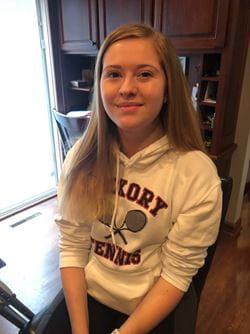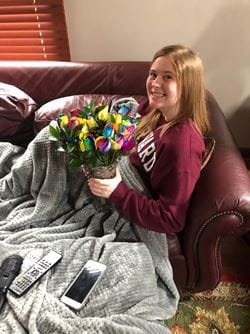“This Isn’t a Forever Thing.”
 On a Sunday evening in February 2019, 16-year-old high school sophomore Emily Spielvogle and three of her friends were on the way from their hometown of Hermitage, Pa. in Mercer County to a faith-based program at Grove City College. Snowy conditions led to the girls being involved in a major car accident involving two tractor trailers. Tragically, two of the girls passed away, while Emily and the other girl were rushed to the nearest Level I Regional Resource Trauma Center in Pittsburgh.
On a Sunday evening in February 2019, 16-year-old high school sophomore Emily Spielvogle and three of her friends were on the way from their hometown of Hermitage, Pa. in Mercer County to a faith-based program at Grove City College. Snowy conditions led to the girls being involved in a major car accident involving two tractor trailers. Tragically, two of the girls passed away, while Emily and the other girl were rushed to the nearest Level I Regional Resource Trauma Center in Pittsburgh.
Emily was in a coma, having suffered trauma to her head as well as severe trauma to one of her feet. Because of the state of her foot, the doctors at the first hospital debated whether amputation was the right course. Ultimately, doctors were able to save the foot through three orthopaedic and plastic reconstructive surgeries immediately following the accident.
Emily also had brain surgery so that doctors could implant a pressure monitor to closely monitor on the swelling in her brain.
Once all of her emergency surgeries were complete, Emily was transferred to UPMC Children’s Hospital of Pittsburgh. She spent a few days at the main hospital in Lawrenceville before being transferred to the Children's Hospital Inpatient Rehabilitation Unit (CHRU) less than a mile from the hospital.
The CHRU is an eight-bed pediatric inpatient rehabilitation unit where caring and seasoned rehab experts provide holistic care for children as young as 6-months up to young adults 25 years of age. At CHRU, a team of doctors, nurses, and therapists work together to optimize the health and function of their patients through innovative, high-quality, team-based, family-centered rehabilitative care.
In January 2023, the CHRU will relocate to the main hospital and grow from eight beds to 12 private rooms. The new and improved unit will feature private therapy rooms, an activities of daily living room, and a gym with state-of-the-art technology.
In recognition of the CHRU team’s dedication and commitment to improving the quality of the lives of the children they serve, CHRU was recently awarded a 3-year accreditation for its Inpatient Rehabilitation Programs – Hospital (Pediatric Specialty Programs) from the Children’s Commission on Accreditation of Rehabilitation Facilities (CARF) International.
Emily would spend the following six weeks at CHRU recovering and rehabilitating after her accident.
Back to the Basics
In addition to physically rehabilitating her foot, Emily had been diagnosed with a severe traumatic brain injury, including diffuse axonal injury (DAI). DAI occurs when the unmoving brain lags behind the movement of the skull, causing nerve fibers (axons) to tear. DAI usually causes coma and injury to many different parts of the brain, as it did in Emily’s case.
“After my accident, I had really bad double vision and memory was a big issue,” said Emily. “I had trouble with reading, attention, comprehension. My mom always tells me that around that time I would be asked to name the days of the week, and I would say, ‘Monday, Tuesday, April, January’ – I knew the significant days and months and things, I just couldn’t put them in order.”
 Emily’s custom-tailored rehabilitation plan included physical, occupational, and speech therapy. She would do two sessions of each, five days a week for the six-week duration of her stay with a goal of improving her gross motor, fine motor, thinking, and communication skills.
Emily’s custom-tailored rehabilitation plan included physical, occupational, and speech therapy. She would do two sessions of each, five days a week for the six-week duration of her stay with a goal of improving her gross motor, fine motor, thinking, and communication skills.
“Starting from scratch is not fun, but [the therapists and doctors] made up games that made it fun,” said Emily. “My occupational therapist Kaitlyn taught me how to do logic puzzles that I still enjoy doing today. We upgraded eventually to baking cakes as part of my therapy which I really enjoyed. They were always looking for different, fun ways to stimulate my brain, and I appreciated that. I worked hard, but I give them a lot of credit."
“Obviously, none of the experience [of the injury and rehabilitation] was particularly fun,” said Emily. “There were a lot of breakdowns, but I just kept reminding myself of all the things I wanted to get back to. I was like, ‘I have to do these things, I want to get back to my sophomore year. I want be tennis captain. Everyone’s here to help me and this isn’t going to be a forever thing. I just have to get through it.”
In addition to rehabilitating her head injuries, Emily’s foot injury was very complex. Initially, Emily – who was not allowed to bear any weight on the foot at that point – couldn’t remember to not place her foot on the ground and wasn't able to maintain her balance.
 As she continued to recover, Emily was able to regain both her balance and her memory. These tools helped her to safely relearn how to walk first with a walker and then eventually with crutches. She learned how to get on and off the floor and how to go up and down the stairs. Emily continued to work hard on her goals after discharge and was able to walk independently and play tennis recreationally.
As she continued to recover, Emily was able to regain both her balance and her memory. These tools helped her to safely relearn how to walk first with a walker and then eventually with crutches. She learned how to get on and off the floor and how to go up and down the stairs. Emily continued to work hard on her goals after discharge and was able to walk independently and play tennis recreationally.
“I had to get a shot in my thighs, and there were so many pills, lots of painkillers. It was hard,” Emily continued. “But everyone there was so great, so friendly. They really helped me through. Spending so much time there, it was like having another family. I got so close with the nurses and doctors, and I keep up with all of them even today.”
When the six weeks came to an end, Emily had made great improvements and was discharged home.
After her inpatient stay, she continued with outpatient rehabilitation, as is typical for most patients when they are discharged from CHRU. She continues to have regular medical appointments with some of her doctors to continue to monitor her recovery.
A New Path
 Nowadays Emily – who will turn 20 in October – is about four years out from her accident and doing well. She is a sophomore studying chemistry at the University of Pittsburgh (Pitt).
Nowadays Emily – who will turn 20 in October – is about four years out from her accident and doing well. She is a sophomore studying chemistry at the University of Pittsburgh (Pitt).
“It’s sometimes weird being so independent now,” says Emily, who lives in an apartment near campus. “Compared to three years ago, it was super questionable if I would be where I am now.”
With the biggest challenges of her rehabilitation behind her, Emily’s goal is to earn her PhD in chemistry and eventually work in UPMC Children’s oncology lab developing new cancer drugs – a goal she says has changed since her accident.
“Before the accident I wanted to be neurosurgeon and I wanted to go to college super far away. Then accident happened. Now, I can’t be a neurosurgeon and I decided that I wanted to stay close to home for college so I had my support system close. In that sense, [the accident] was humbling. But I’m happy with my new course,” said Emily.
“My dad is an oncologist and before the accident I spent a lot of time volunteering in the oncology unit. I always hated chemo and seeing what chemo does to people. It kills cancer, but it makes people really, really sick in the process. I want to fix that,” continued Emily about choosing her new career path.
Alternatively, she says she may want to become an organic chemistry professor, an interest that was sparked by serving as an undergraduate teaching assistant through the American Chemical Society at Pitt.
Outside of her schoolwork, an activity that brings Emily a lot of joy and fulfillment has been her involvement with an organization where students dress as princesses and other lovable characters and visit pediatric patients in health care settings like UPMC Children’s. In fact, she first learned about the organization when she herself was visited by a princess while in the CHRU.
After her inpatient stay, she continued with some outpatient rehabilitation, particularly to work on walking and running. Living off campus, Emily walks about 5 miles each day. Through the continued outpatient physical therapy, she was able to rid herself of her limp and lessen the pain she experiences in her foot after prolonged activity.
When asked what advice she would offer someone who found themselves in a similar situation to hers, Emily said, “I would tell them I’m sorry. Car crashes are terrible and horrible and so traumatic. But it’s going to be fine. You have to work through it, but like I told myself, this isn’t a forever thing. And everyone at the hospital or rehab center is there to help you. Nobody’s rooting against you. This is your biggest team of supporters. Keep working hard. Keep doing what you’re doing. It’s a marathon, not a sprint.”
Emily’s treatment and results may not be representative of other similar cases.









